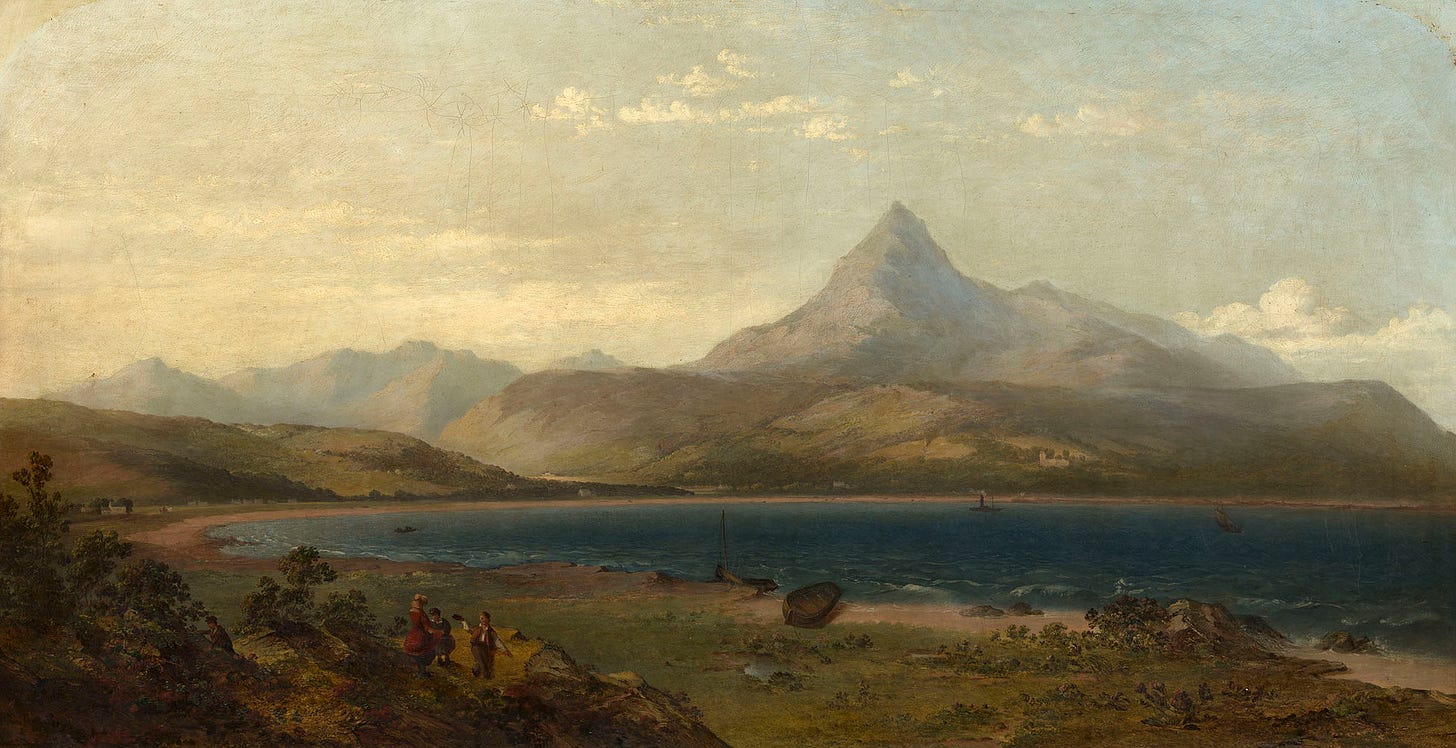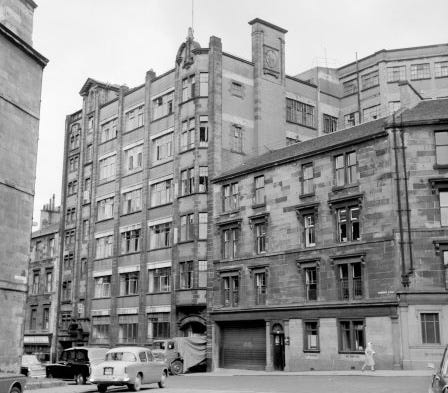An earlier article looked at the Stockwell Street tenement that might have been ordered from the architectural practice of Baird & Thomson on behalf of the Ure family of bakers, based near the Bridgegate. The Ures went on to become socially successful.
There was another bakery connection to the Thomson family, through the marriage of Alexander Thomson’s fifth daughter Jessie Williamina (1858-1928), to Adam Cairns (1858-1935). Jessie was born at 3 Darnley Terrace, the Thomson-designed terrace in Shawlands from which they relocated to Moray Place once that was ready for occupancy. She studied at Langside Academy, another Thomson building, where she won awarded a certificate of merit in English. After Thomson’s death in 1875 she continued living at Moray Place, where in 1881 she described her occupation as ‘Income from Interest of Money’.
The Cairns were in Paisley by the late 18th century, having possibly moved there from Fife. In 1820, Adam Cairns married Janet Haldane in Paisley Abbey. For many years he worked as a weaver; he described himself as a ‘silk warper’ in 1841, by which time all eight of his children - two sons and six daughters - had been born.
How the change of career and location are about isn’t known, but by mid-1847 he was Manager of the Friendly Bread Association, living at 29 Eglinton Street (he would live at various Eglinton Street addresses over the next few years)1.
Cairns joined the Association at a difficult time. A few years later, in Baker Street, Crossmyloof, Alexander Thomson would design cottages for workers at Neale Thomson’s Crossmyloof Bakery. Neale (not a relation), lived at Camphill House for some years and was a benevolent employer by all accounts. But the Crossmyloof Bakery was his business, as was the Ure’s business in Bridgegate. The Friendly Bread Association by contrast was, essentially, a cooperative, producing bread that was sold at near-cost price to bakers who then retailed it through their own shops. The Association had been in existence since March 1825, with offices were at Carlton Court, 13 Bridge Street (between Portland and Eglinton Streets), but these, together with the bakehouse, neighbouring dwelling-houses, Mr Bowman’s piano factory and adjoining stables all burned down in 1846 (the fire having started in a neighbouring bakehouse)2. The Association’s premises must have been sufficiently insured for it to continue and rebuild; by 1853, under Cairns’ management, it was doing well enough to looking for larger premises, either to lease or to build on3. He had retired by mid-1873, a year after the death of his wife, and died suddenly in Abbotsford Place in December 1880.
Children of Adam Cairns and Janet Haldane
Adam and Janet’s eldest son was John Cairns (1820-1867) who, aged 20, was a pattern drawer, living with his family in Thread Street. He was talented, however, becoming a recognised portrait and landscape painter, some of whose works can be seen here, and are held in various collections, including the Royal Collection (below).
In 1854, John married Jane Duff in Glasgow; in July 1855 she gave birth to a daughter, but died a month later. John married again, in Rothesay in 1857, but there seem to have been no children from that marriage. He and his family moved to Edinburgh; he exhibited regularly at the RSA between 1845 and 1867, the year in which he died suddenly from acute peritonitis. After his death, ‘some good Dundee friends’ paid his widow £100 for his last work, a Highland landscape4.
Adam and Janet’s second eldest daughter, Mary, married and had five children with Alexander Brownlie, a carpet pattern maker who was always based in the east end of Glasgow, and might have worked for Templeton’s or one of the other manufacturers in the area. The third, Helen, married Matthew Brown, a Paisley baker who purchased an existing successful business there in the 1860s, and became involved in local polities, being elected to the Paisley Parochial Board in 1869 and 1874, the year in which he died from consumption, aged 50. Three of his five children pre-deceased him and one died the following decade, leaving only a daughter, who died unmarried in 1913.
The next daughter, Margaret, married a cotton store keeper, later grocer, from Dunoon, to which the family moved in the 1860s and remained. The next sister, Janet, married Thomas Smith, senior partner in a long-established manufacturing stationery business in Kilmarnock, one of whose two sons carried on the business after his father’s sudden death in 1909, two weeks’ short of celebrating his golden wedding. The youngest daughter, Christina, married David Henderson Roberts, an accountant originally from Linlithgow, but with a practice in Falkirk. They had six children together before his death in Glasgow in 1876 at the age of 39.
William Cairns, the only other son of Adam and Janet, became a successful plumber in Glasgow. Born in Paisley, he worked as a journeyman plumber around Scotland before setting in Glasgow. There, at different times, various members of the Cairns family lived in Abbotsford Place (William was there in the mid-1860s). In 1857 he had married Elizabeth Graham, who bore him three children - two sons and a daughter - before her death in 1866, giving birth to her last child, a third son. William married again the following year, to Janet Bauchope, who bore him two more sons, but it was William’s eldest son from his first marriage, Adam (1858-1935), who married Alexander Thomson’s daughter, Jessie Williamina.
Adam Cairns, son-in-law
While some of his brothers followed their father into the plumbing trade, Adam instead trained as an analytical chemist (working in Edinburgh as a chemist’s clerk in 1881). We don’t know when and where he met Jessie, daughter of the now-deceased Alexander Thomson, who was still living at Moray Place. It is possible they met as members of the Caledonia Road Church (where they married in 1888), since he was living at 53 Shields Road at the time of their marriage, and gave ‘Mercantile clerk’ as his occupation. They were both in their late twenties.
Their first son, William, was born in 1890 when Adam and Jessie were living at 25 Princes Street, Pollokshields. Two more daughters, Jane Nicholson in 1892, Elizabeth Graham in 1894, and a second son, George Thomson, in 1895, were born there. By now, Adam had progressed from clerk to salesman, working for James Miller, Son & Co., who supplied ‘gas and mineral oil products, chemicals, drysalteries, aniline colours, and cannel coals [a kind of shale]’. The family next moved to 150 Nithsdale Road, where the seven year-old William Cairns died in 1897 from bronchial pneumonia.
By mid-1900, the family had moved to Newlands, into ‘Ingleside’ at 21 Monreith Road, Newlands, joined next door, in ‘Ingleneuk’ at No. 19, by his wife’s brother, the architect John Thomson, and his family. This was one of two pairs of semi-detached houses designed by John Thomson; on stylistic grounds, the others were probably Nos. 25 and 27, not least because one of them (above) was occupied by another brother-in-law, James Black Anderson, who had married Helen (‘Nellie’) Thomson, Jessie’s younger sister5.
Jessie died in January 1928; three years later, Adam married again, at the age of 72, to Agnes Robertson, the widow of Alexander Thomson’s youngest son, Michael Nicholson, a civil engineer who had died in London back in 1895. Adam died in 1935, Agnes in 1952
George Thomson Cairns, Adam and Jessie’s surviving son, was killed in action in France in June 1918, as a Lieutenant with the Cameronians (Scottish Rifles). The following year, Jane Nicholson married William Hutcheon Marr at Caledonia Road; they had two sons together and he went on to become minister at Kilmacolm. Her younger sister, Elizabeth Graham, never married, and died in 1962; Jane Nicholson died in Port Glasgow in 1979.
The Glasgow Friendly Bread Association
Six years after Adam Cairns retired, Carlton Court was leased out in 1879; by 1885 the Association was looking for more premises, claiming sufficient reserves to enable it to resist any anticipated increases in the world price of flour6. By mid-1887, the Association had opened a new bakery in Clarendon Lane (now Clarendon Street), off Great Western Road. While most of Glasgow’s 240-plus bakers’ and pastry shops that year were single-owner outlets, there were larger operations: the Bridgeton Society; the Cranstonhill and Plantation Bakeries (with a separate business in London); the Crossmyloof Loaf Factory with its various branches; Gray, Dunn, & Co. in Kinning Park, with their neighbours the Kinning Park Baking Company; Walter Hubbard in Partick, Hillhead and Strathbungo (who would replace Thomson’s stables in Otago Street); and McFarlane, Lang & Co.’s Victoria Bread and Biscuit Factory in Wesleyan Street. At this point, the future concerns of Bilsland Brothers had only two outlets, and M & A Brown a single shop in Sauchiehall Street.
The greatest competition came from the Scottish Co-operative Wholesale Society, initiated in Barrhead in 1865 and established in 1868 involving 28 stores, increasing to 138 stores within five years and 231 by 1887, with some 77,000 members7. In 1892 the Association was seeking new members, its assets having dropped to just over £2,000; in 1894, it was re-established as a limited company8, which then bought up the assets of the Association9, which itself was wound up voluntarily in December 1897.
By the 1890s, Paisley-born Robert Urie, sone of a master baker there and sometime salesman for the Kingston Grain Mills, had been Manager of the Kinning Park Baking Company Ltd, based at Stanley Street, Paisley Road, since 1884. He now became managing director of the Friendly Bread Co., Ltd, based at Clarendon Lane, while retaining his role in the Kinning Park enterprise. By 1905, the company had become ‘City Bakeries, Ltd. (successors to Glasgow Friendly Bread Association)’10. Robert’s sons, John and William, expanded the business, establishing the Ca’Doro Restaurant in Union Street (below, in 1936).
The Clarendon Lane premises were replaced around 1927 (below), and City Bakeries grew to encompass some 60 shops before being taken over by Allied Bakeries Ltd. By 1§993, the number of shops had reduced to 27, almost half of them in Glasgow, when the business, which now operated under various trading names (including Baker’s Oven) was closed. The bakery buildings are now apartments.
The Cairns and Urie families are shown in the Combination Tree on www.ancestry.co.uk
Glasgow Post Office Directory, 1847
Glasgow Herald, 16 Nov 1846
North British Daily Mail, 20 Jan 1853
Greenock Telegraph and Clyde Shipping Gazette, 6 May 1867
Glasgow Post Office Directory, 1894; 1900
Glasgow Evening Post, 7 Mar 1883; Glasgow Herald, 4 Mar 1885
Glasgow Weekly Herald, 1 January 1887
Glasgow Evening Post, 28 Aug 1892; North British Daily Mail, 18 Oct 1894
Dundee Courier, 4 Dec 1897
Glasgow Post Office Directory, 1905







